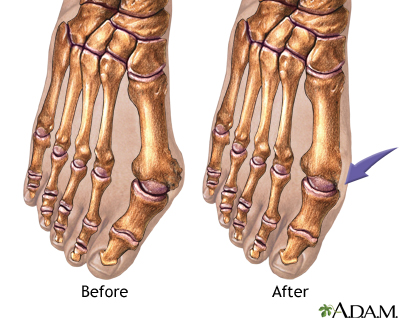Dealing With A Bunion
Overview
 Hallux Abducto Valgus, commonly called bunion, is a bony deformity affecting the angle of the joint at the base of the big toe. Some medical professionals believe that the condition is solely due to ill-fitting footwear, while others believe it is a genetic structural defect that can be exacerbated by shoes. Despite the varying opinions, the reality is that it is probably a combination of both factors. A bunion forms when pressure is applied to the side of the big toe, causing it to become inflamed and painful. The joint then protrudes, effectively making the foot wider. The second toe might then become displaced, which can cause a multitude of other issues like corn and callus development. The bunion joint will have a reduced range of motion and often ends up arthritic. The condition usually develops later in life.
Hallux Abducto Valgus, commonly called bunion, is a bony deformity affecting the angle of the joint at the base of the big toe. Some medical professionals believe that the condition is solely due to ill-fitting footwear, while others believe it is a genetic structural defect that can be exacerbated by shoes. Despite the varying opinions, the reality is that it is probably a combination of both factors. A bunion forms when pressure is applied to the side of the big toe, causing it to become inflamed and painful. The joint then protrudes, effectively making the foot wider. The second toe might then become displaced, which can cause a multitude of other issues like corn and callus development. The bunion joint will have a reduced range of motion and often ends up arthritic. The condition usually develops later in life.
Causes
Essentially, bunions are caused by a disruption of the normal interworking of the bones, muscles, ligaments and tendons that comprise your feet, often from wearing shoes that squeeze the toes or place too much weight-bearing stress on them. However, it should be pointed out that other causes or factors in the development of bunions can include flat feet or low arches in the feet, some forms of arthritis, problems with foot mechanics, foot injuries and neuromuscular disorders such as cerebral palsy. Arthritis in the MTP joint, for example, can degrade the cartilage that protects it, and other problems may cause ligaments to become loose. Pronation, walking in a way that your foot rolls inwards, increases your risk for developing bunions.
Symptoms
Bunions may or may not cause symptoms. A frequent symptom is foot pain in the involved area when walking or wearing shoes that is relieved by resting. A bunion causes enlargement of the base of the big toe and is usually associated with positioning of the big toe toward the smaller toes. This leads to intermittent or chronic pain at the base of the big toe. Bunions that cause marked pain are often associated with swelling of the soft tissues, redness, and local tenderness. It is important to note that, in post-pubertal men and post-menopausal women, pain at the base of the big toe can be caused by gout and gouty arthritis that is similar to the pain caused by bunions.
Diagnosis
Generally, observation is adequate to diagnose a bunion, as the bump is obvious on the side of the foot or base of the big toe. However, your physician may order X-rays that will show the extent of the deformity of the foot.
Non Surgical Treatment
Most bunions can be treated without surgery. The first step for treating bunions is to ensure that your shoes fit correctly. Often good footwear is all that is needed to alleviate the problem. Shoes that are wide enough to avoid pressure on the bunion are the obvious first step. Look for shoes with wide insteps and broad toes and definitely no high heels. Sometimes, you can get your existing shoes stretched out by a shoe repairer. Seek advice from a podiatrist. Pads and toe inserts. Protective bunion pads may help to cushion the joint and reduce pain. Toe inserts are available that splint the toes straight. It may be recommended that you wear some orthotics to improve your foot position when walking. Medicines. Some people find anti-inflammatory medicines, such as ibuprofen or aspirin, or paracetamol help ease the pain of their bunions. 
Surgical Treatment
Some sufferers choose to have the bunion surgically removed. This should always be a last resort as all surgeries carry risks. There are several types of surgical procedures to remove bunions and before deciding, you should speak to your surgeon at length about the facts and risks associated with surgery, including the recovery time and success rate of the operation to be done. Please note that if you have a surgical procedure and then return to your high heels and narrow-toed shoes, the bunion is likely to reoccur.
Prevention
Here are some tips to help you prevent bunions. Wear shoes that fit well. Use custom orthotic devices. Avoid shoes with small toe boxes and high heels. Exercise daily to keep the muscles of your feet and legs strong and healthy. Follow your doctor?s treatment and recovery instructions thoroughly. Unfortunately, if you suffer from bunions due to genetics, there may be nothing you can do to prevent them from occurring. Talk with your doctor about additional prevention steps you can take, especially if you are prone to them.